PLM Europe 2016 in Berlin
Monday 17th Oct. 2016 - Wednesday Oct. 19th 2016, Estrel Convention Centre Berlin / Germany
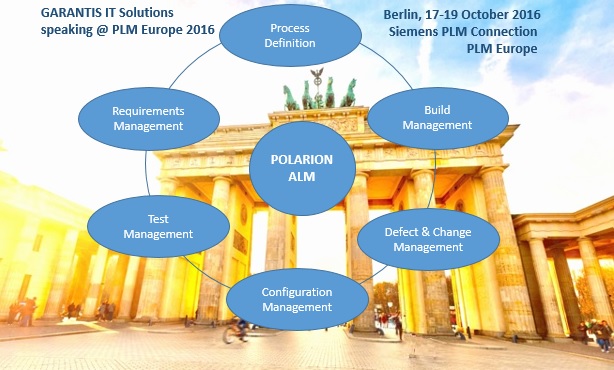
Close to 1.000 participants from 30 different countries are expected to take part in PLM Europe 2016 in Berlin, organized by Siemens. Siemens is leading provider of PLM Solutions (Product Lifecycle Management).
PLM Europe is a great channel to network with users of Siemens PLM Software internationally, and from 2016 also with users of Polarion ALM (acquired by Siemens in 2016).
More information: www.plm-europe.org
See you at PLM Europe?
Come and meet GARANTIS IT Solutions at PLM Europe 2016 in Berlin.
We will be pleased to share and demonstrate our knowledge in Polarion ALM.
Share Expert Knowledge - Meet us at the Conference
GARANTIS will be available to discuss your strategic requirements for ALM Solutions:
- Which ALM solution is good for you?
- Choosing Polarion as ALM solutions
- Initial Setup of Polarion
- Customizations & Maintenance
- Process definition and Implementation of Processes in Polarion
- Integrations (Jenkins, Polarion, GIT, etc)
- Tricks & Tips
We are involved every day in short-term and long-term contracts during all stages of the software development projects.
To share our knowledge with you will be a pleasure for us.
|

|
|
Meet us after the Conference
We are always available to support our clients and to give free advise:
E-mail: info@garantis.co.uk
Direct Phone: +44 (0) 118 343 1584
Additional Info
Product lifecycle management (PLM) is an information management system that can integrate data, processes, business systems and, ultimately,
people in an extended enterprise. PLM software allows you to manage this information throughout the entire lifecycle of a product efficiently and cost-effectively,
from ideation, design and manufacture, through service and disposal.
Source: Siemens PLM site
Polarion offers a complete Application Lifecycle Management (ALM) suite to offer greater visibility into the software development process.
Polarion is a unified solution for Requirements, Quality, and Application Lifecycle Management.
Polarion Software was acquired by Siemens PLM Software in January 2016, expanding their support for the growing ALM market.
Diary of the Conference
Day 1, 17 October 2016
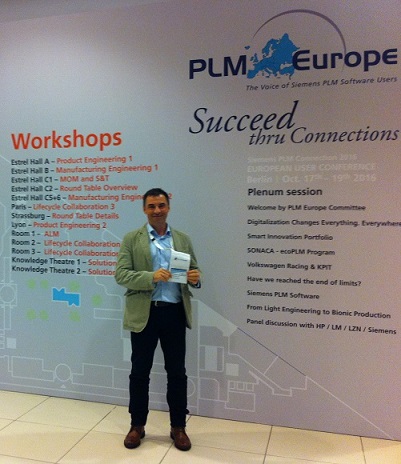
Representative of GARANTIS IT Solutions among speakers at PLM Europe 2016.
Our presentation topic: "Polarion Customization (presented by GARANTIS IT Solutions)"
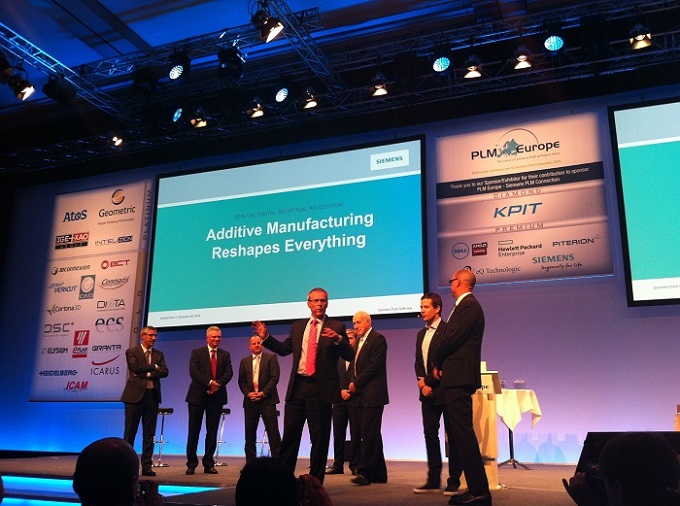
On the first day the main focus was on manufacturing: new technologies, such as Additive Manufacturing, 3D printing. These technologies allow to build connection from PLM tools (such as Teamcenter) to 3D printers and robotic machines, which can autonomously build the final product.
Sounds like a "Future", but looks like it is coming...
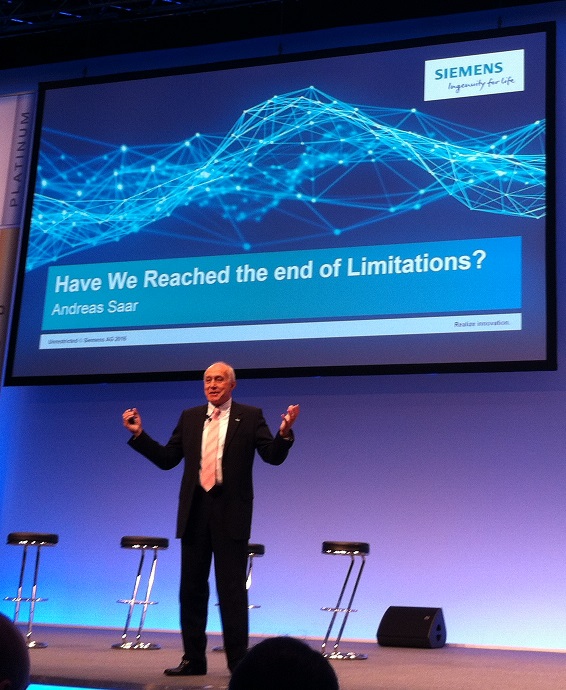
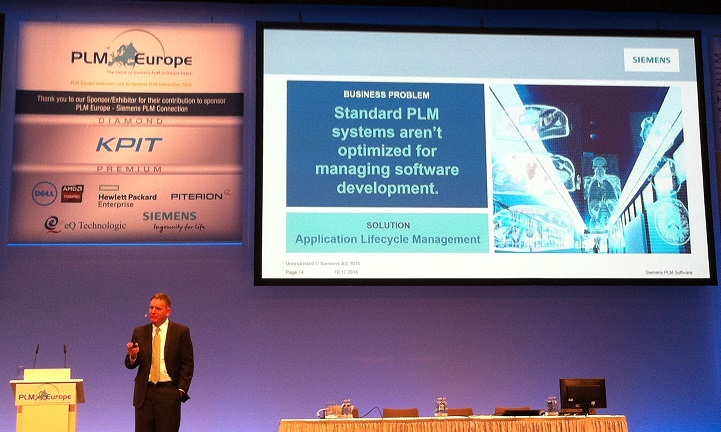
There is big future for Polarion ALM in the family of Siemens products. It will be integrated with Teamcenter.
Teamcenter itself, as pure PLM product, "is not optimized for managing software development".
Day 2, 18 October 2016
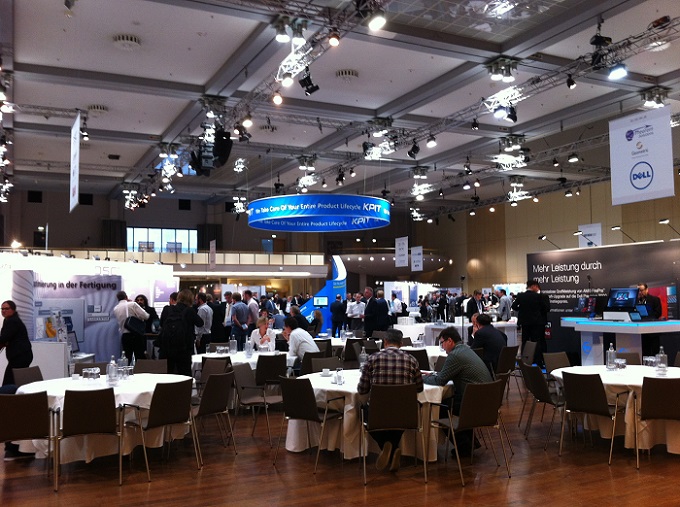
There were many discussions in Exhibitor's Hall. Networking, networking, networking...
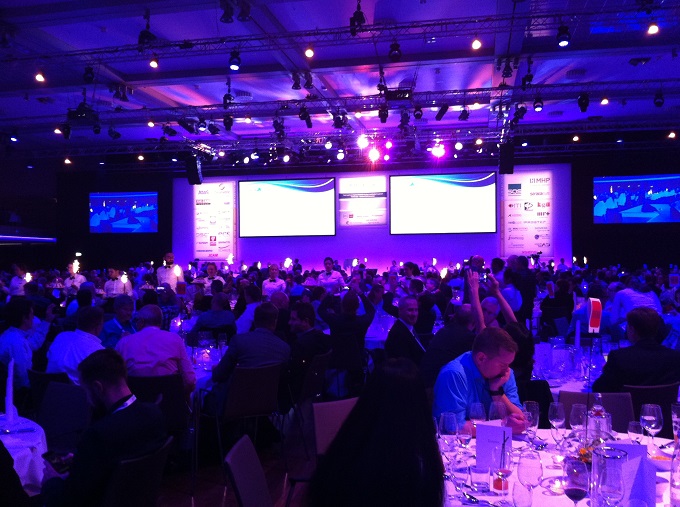
Gala Dinner. Evening entertainment with iPad magician Simon Pierro.
Day 3, 19 October 2016

The Conference was only for 1/2 day on this day.
After productive 2.5 days was time to go home...
See you next year in Berlin!
Review of the Conference - what was said about Polarion ALM
Why visit the Conference?
There are different reasons to participate in the Conference:
- to find out the latest news about the products and the strategic plans for the future.
- to have a chance to see key people (Project and Product Managers, Developers, Consultants) and to ask questions.
If you do not come to the conference - then you do not have access to these people.
- to listen to other people, about their experience. Case stories presentations show how the products can be used and give you good ideas.
- become known in the professional circles. If you have something to say - then the conference is the best place to become known and to share your ideas.
Polarion vs Teamcenter? What is the Future?
There was the same information comming from different sources during the conference: Polarion and Teamcenter will co-exist in parallel.
They will be gradually connected better and better.
There is no need to switch from Teamcenter to Polarion or from Polarion to Teamcenter.
Each product has own advantages, and together they allow to solve Product Development tasks : Teamcenter can be PLM tool, and Polarion - ALM tool.
For example, for Software Development it is better to use Polarion. But for hardware parts and mechatronics - Teamcenter.
A lot of work is going on to integrate Teamcenter and Polarion. There are already examples of this integration working.
Next steps are to make it "more smooth" , "more natural", to provide more functions and satisfy requests from customers.
Why Polarion ALM is good and needed? - (*) Polarion is for a system-driven product development,
(*) it is a complex tool, but user experience is made as easy as possible, (*) roll-out of Polarion is "just days", not weeks or months.
DIFFERENCE between ALM and PLM:
As Jiri Walek said: "there is only one letter difference "A" and "P" - between ALM and PLM".
ALM = is "more than Requirements" => "down to the software line of code".
PLM => down to the Bill Of Materials (BOM) and simulation of the product.
ALM and PLM have a lot of common, but obviously there is a difference: what is managed, who works with each tool, how users expect to see information,
what functionality and behaviour they expect from the tools in Product and in Application Lifecycle Management.
Digital Factory concept
"Digitalization is everywhere and is changing all industries". Siemens, after recent purchases, is in good shape to be in a leading position for complete PLM.
There was a lot of information about Digital Factories, Smart Factories. You could even visit a demonstartion room called "Digital Factory Experience".
The main idea of Digital Factory: to have complete continious chain from Product Concept to Product Design, and then "feeding" the design documents to robots in Digital Factory, allowing them to make the product (or parts) autonomously.
Even though Polarion does not have direct link to Digital Factory concept, it will be part of the PLM/ALM solution and consequently can be/will be used together with Teamcenter to describe Specifications and Design, or to manage Requirements, Defects, Change Requests etc.
Technichaly Teamcenter has (will have) programming interface to the machinery in the Factory and can control manufacturing process. Good examples were Local Motors, who 3D printed complete car.
Polarion ALM presentations - Case Studies from Customers
Starting from the first day there were many presentations about Polarion in Room I.
SUMMARY:
- generic presentations "what is Polarion" and "Polarion place in ALM/PLM"
- ideas about connecting PLM + ALM, Mechatronics + SW development, Teamcenter + Polarion ALM
- using Agile approach in projects managed by Polarion ALM
- future plans and planned features in Polarion. Presentation "Polarion ALM tomorrow" by Jiri Walek (Siemens PLM Software)
- case studies from customers, including our presentation
"Polarion Customization (presented by GARANTIS IT Solutions)"
Below is the list of some presentations selected by us. We give short description and our recommendations/comments.
"Polarion Customization (presented by GARANTIS IT Solutions)"
- This is a Case Study about Customization of Polarion, It describes specific technical solutions for Feature Driven Development customization.
Also we touched topics common for all projects: * How to convince management that customization is needed? * How to administer multiple projects and propagate changes effectively? * What do you need to customize? * How to inform team about customizations?
- CUSTOMER STORY:The company wanted to use Feature Driven Development (FDD) approach to accelerate development of software for the Thermomix TM5 product. Polarion was chosen as ALM tool, but it needed to be adapted/customized for FDD.
FDD process focus points are:
• Build feature list
• Plan by feature
• Design by feature
In this project we used complete range
of Polarion features:
• Workflows, WorkItems, Custom Fields
• Different Views for different Roles
• Planning , PLAN pages (Sprints)
• Testing , TestRuns, TestCases,
manual Test Case Execution
..and created some extensions:
• Build Record
• Report about Testing of BuildRecord
• Auto generated Release Note
What is special about the project?
• We took ideas from different Templates to combine
them into single Template
• Plans, Reports, WorkFlows, InfoPages, Documents, etc
• FDD process was mapped to Polarion‘s
Workflows/Links/WorkItems
|
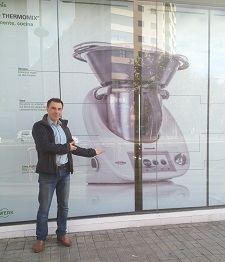
|
"Application Lifecycle Management: how to do the right thing in managing software development" Frank Schröder (Siemens PLM Software) , Stefano Rizzo (Siemens PLM Software)
- This presentation described role of Polarion in Application Lifecycle management. There were some words about "what is Polarion", "which functions it provides". Also the global concept was explained about ALM inside PLM.
- There is more an more Software, and the ALM shall be managed somehow. Polarion - is the good solution, because it coveres Requirements management, Testing and QA, Defect management and can be easily extended using plugins.
- IoT 4.0 and IIoT (Industry Internet of Things) - this needs to be managed.
IOT will changes everything, especially how software has been developed. by Stefano Rizzo about ALM and IOT
"Working with Polarion ALM and Teamcenter: key use cases of the integration" by Clara Vincenc Cismaru (Siemens PLM Software)
- modern product include "hardware" product + "software" product. Software is everywhere.
- not conencted PLM and ALM tools can cause errors in fucntioning of "software" + "hardware".These failures have affected both the consumers and the vendors, in some cases with dramatic effects.
- In most of these situations the cause is the disconnection between PLM and ALM.
- SOLUTION: better connections betwee PLM+ALM. Better connection between Teamcenter and Polarion. Better product "Teamcenter-Polarion Connector"
- There are big plans to improve conenction between Teamcenter and Polarion. At the moment the connection already exists and is implemented by "Connector".
"Connector" allows to establish links between elements in Teamcenter and Polarion. In Teamcenter you can click on the Link and you can see content of Polarion work item (in Active workspace).
Later additional functionality will be added, such as "semantics" of the lniks; reports, which show items from both Teamcenter and Polarion.
Next update of Connector is planned in 2017.
"PLM/ALM for Smart Products" by Prof. Andreas Deuter (OWL University of Applied Sciences)
- This is a presentation about Teamcenter+Connector+Polarion integration. SmartFactory OWL has this connection installed and configured. If you are looking for similar connection - ask SmartFactory OWL!
- The “PLM/ALM for Smart Products” research project in the SmartFactory OWL aims to explore intelligent development processes for smart products with regard to Industrie 4.0. In this context, Siemens Teamcenter and Polarion ALM are used to create detailed use cases for the consistent management of product data to be tested regarding applicability in specific product developments.
- This presentation shows specific PLM/ALM use cases that are realized in der SmartFactory OWL with the use of Siemens Teamcenter and Polarion ALM, discussing the advantages of the current PLM/ALM integration from the user’s point of view and providing recommendations for improvements.
"Agile and Enterprise Agile: speed up your software development" by Jiri Walek (Siemens PLM Software)
- very nice insight into Using of Agile in Polarion ALM.
- there are some new features and a new project Template available ("Iterations" in plans, for example).
- This presentation looks at how to scale Agile to support large project/products porfolio and how to structure the organization and Polarion ALM deployment to give people the right content to make decisions and distribute the information across large project set.
- NEW IDEAS: Iterations in plans, use 1 polarion project - per 1 team, planing for teams, getting overview across different teams.
"Agility squared - Polarion as systems engineering platform for eCar" by Axel Biedermann (Siemens AG)
- interesting practical presentation about using agile development model in Polarion ALM. It contains diagram of work item types and linking.
- shows how to be compatible with ISO26262, Automotive Spice, CMMI
- how to make Polarion ALM a "quick tool for developers". For developers "it makes sense if information can be entered, retrieved and analyzed quickly".
- "The data quality has been improved dramatically and the effort for documentation, data retrieval and reporting could be significantly reduced.".
"Requirements Engineering integration in Product Lifecycle Management" by Dr. Benedikt Busse (Miltenyi Biotec GmbH)
- interesting practical presentation about Product Data Management in Polarion ALM. The data cover: requirements, risk management and tests.
- SUMMARY: "Different document types (e.g. external test reports) can easily be linked with Polarions test management and documentation of product realization and iteration with test management can be performed by direct links to primary and single source of information. Documentation becomes a daily helper for creative developers instead of a regulatory burden."
"Managing ALM and convergence with PLM across global teams in AGCO - status vs. vision" by Daniel Höllisch (AGCO GmbH)
- "PLM solutions are less capable at managing the SW development process". SW development lifecycle is fundamentally different than the development lifecycle for machines, SW artifacts need to be managed in more "granular fashion".
- "SW development is still part of the machine development process. It is necessary to connect the data that is common in both worlds and gradually converge these domains over the next years."
- "machine to machine networking and the Internet of Things (IoT)"
"V-Model Projects in Polarion" by Guido Kuepper (DSA GmbH)
- "minimal base templates" - single workflow was used for all workitem types. This simplified Reporting, because the states are the same - you do not need to change/detect differnt workflow states. Also simplified maintenance.